Seasonic Focus Plus 750 Gold PSU Review
Why you can trust Tom's Hardware
Transient Response Tests
Advanced Transient Response Tests
For details on our transient response testing, please click here.
Ιn these tests, we monitor the SSR-750FX's response in several scenarios. First, a transient load (10A at +12V, 5A at 5V, 5A at 3.3V, and 0.5A at 5VSB) is applied for 200ms as the PSU works at 20 percent load. In the second scenario, it's hit by the same transient load while operating at 50 percent load.
In the next sets of tests, we increase the transient load on the major rails with a new configuration: 15A at +12V, 6A at 5V, 6A at 3.3V, and 0.5A at 5VSB. We also increase the load-changing repetition rate from 5 Hz (200ms) to 50 Hz (20ms). Again, this runs with the PSU operating at 20 and 50 percent load.
The last tests are even tougher. Although we keep the same loads, the load-changing repetition rate rises to 1 KHz (1ms).
In all of the tests, we use an oscilloscope to measure the voltage drops caused by the transient load. The voltages should remain within the ATX specification's regulation limits.
These tests are crucial because they simulate the transient loads a PSU is likely to handle (such as booting a RAID array or an instant 100 percent load of CPU/GPUs). We call these "Advanced Transient Response Tests," and they are designed to be very tough to master, especially for a PSU with a capacity of less than 500W.
Advanced Transient Response at 20 Percent – 200ms
| Voltage | Before | After | Change | Pass/Fail |
|---|---|---|---|---|
| 12V | 12.138V | 12.063V | 0.62% | Pass |
| 5V | 5.005V | 4.901V | 2.08% | Pass |
| 3.3V | 3.299V | 3.147V | 4.61% | Pass |
| 5VSB | 5.083V | 5.037V | 0.90% | Pass |
Advanced Transient Response at 20 Percent – 20ms
| Voltage | Before | After | Change | Pass/Fail |
|---|---|---|---|---|
| 12V | 12.137V | 12.023V | 0.94% | Pass |
| 5V | 5.005V | 4.874V | 2.62% | Pass |
| 3.3V | 3.299V | 3.115V | 5.58% | Fail |
| 5VSB | 5.083V | 5.049V | 0.67% | Pass |
Advanced Transient Response at 20 Percent – 1ms
| Voltage | Before | After | Change | Pass/Fail |
|---|---|---|---|---|
| 12V | 12.137V | 12.029V | 0.89% | Pass |
| 5V | 5.006V | 4.882V | 2.48% | Pass |
| 3.3V | 3.299V | 3.111V | 5.70% | Fail |
| 5VSB | 5.083V | 5.052V | 0.61% | Pass |
Advanced Transient Response at 50 Percent – 200ms
| Voltage | Before | After | Change | Pass/Fail |
|---|---|---|---|---|
| 12V | 12.131V | 12.062V | 0.57% | Pass |
| 5V | 4.994V | 4.887V | 2.14% | Pass |
| 3.3V | 3.287V | 3.127V | 4.87% | Fail |
| 5VSB | 5.045V | 5.006V | 0.77% | Pass |
Advanced Transient Response at 50 Percent – 20ms
| Voltage | Before | After | Change | Pass/Fail |
|---|---|---|---|---|
| 12V | 12.132V | 12.029V | 0.85% | Pass |
| 5V | 4.994V | 4.872V | 2.44% | Pass |
| 3.3V | 3.288V | 3.100V | 5.72% | Fail |
| 5VSB | 5.045V | 5.006V | 0.77% | Pass |
Advanced Transient Response at 50 Percent – 1ms
| Voltage | Before | After | Change | Pass/Fail |
|---|---|---|---|---|
| 12V | 12.133V | 12.035V | 0.81% | Pass |
| 5V | 4.994V | 4.864V | 2.60% | Pass |
| 3.3V | 3.288V | 3.093V | 5.93% | Fail |
| 5VSB | 5.045V | 4.996V | 0.97% | Pass |

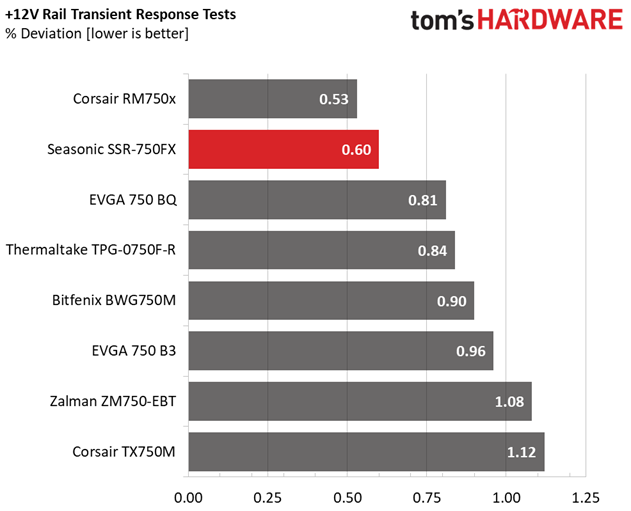



The +12V rail's performance is quite good. But we can't say the same for Seasonic's 3.3V rail, which fails almost every test. Apparently, the 3.3V rail's performance is the weak link here, and Seasonic should improve it as soon as possible.
Get Tom's Hardware's best news and in-depth reviews, straight to your inbox.
Here are the oscilloscope screenshots we took during Advanced Transient Response Testing:
Transient Response At 20 Percent Load – 200ms




Transient Response At 20 Percent Load – 20ms


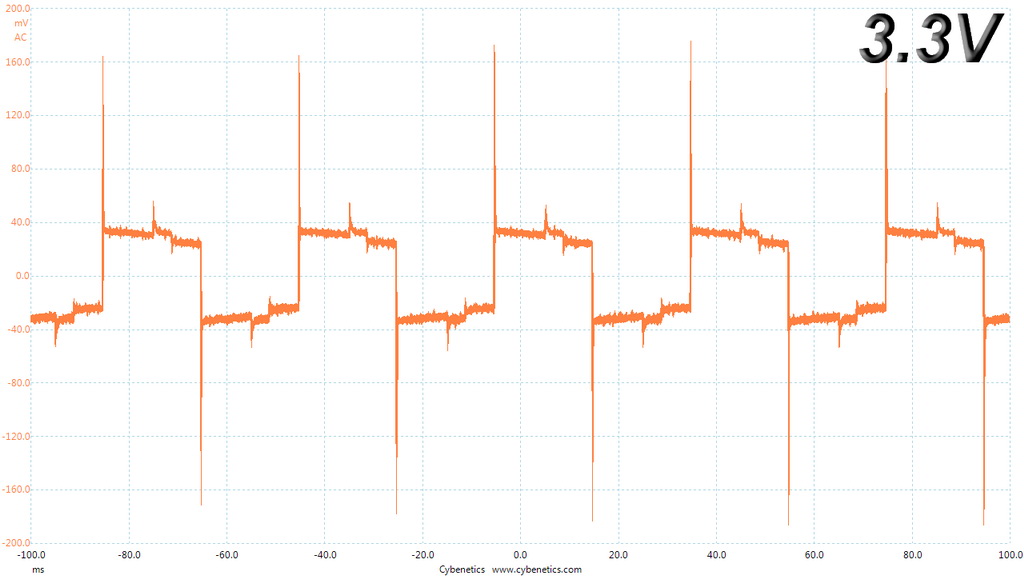

Transient Response At 20 Percent Load – 1ms

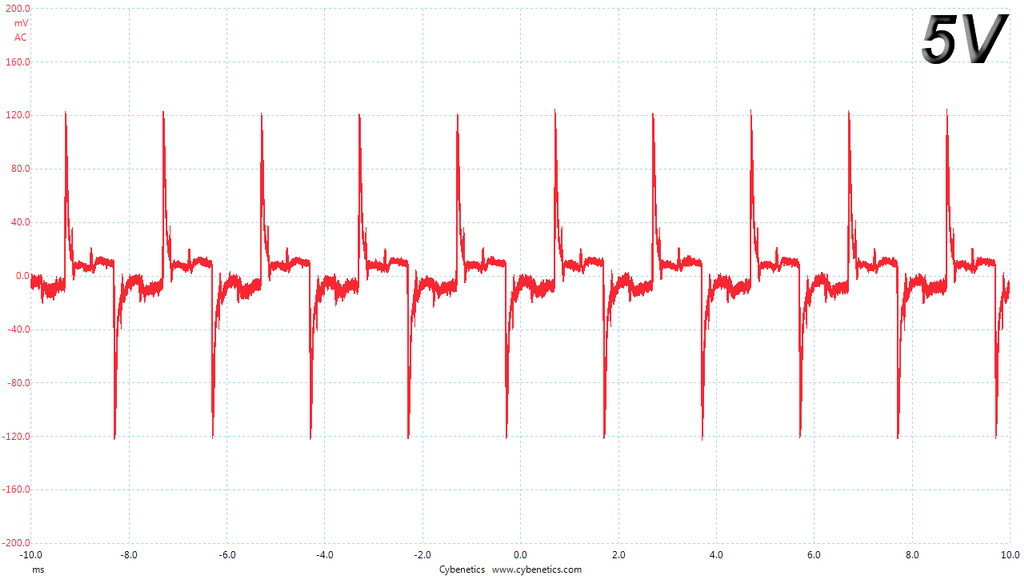


Transient Response At 50 Percent Load – 200ms




Transient Response At 50 Percent Load – 20ms

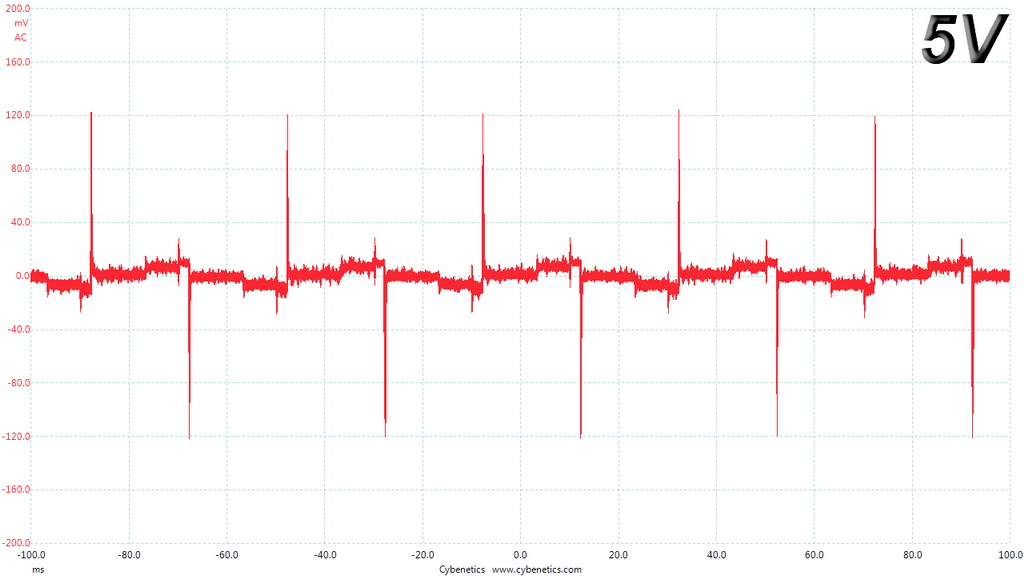


Transient Response At 50 Percent Load – 1ms




Turn-On Transient Tests
In the next set of tests, we measured the SSR-750FX's response in simpler transient load scenarios—during its power-on phase.
For our first measurement, we turned the SSR-750FX off, dialed in the maximum current the 5VSB rail could output, and switched the PSU back on. In the second test, we dialed the maximum load the +12V rail could handle and started the 750W supply while it was in standby mode. In the last test, while the PSU was completely switched off (we cut off the power or switched the PSU off), we dialed the maximum load the +12V rail could handle before switching it back on from the loader and restoring power. The ATX specification states that recorded spikes on all rails should not exceed 10 percent of their nominal values (+10 percent for 12V is 13.2V, and 5.5 V for 5V).
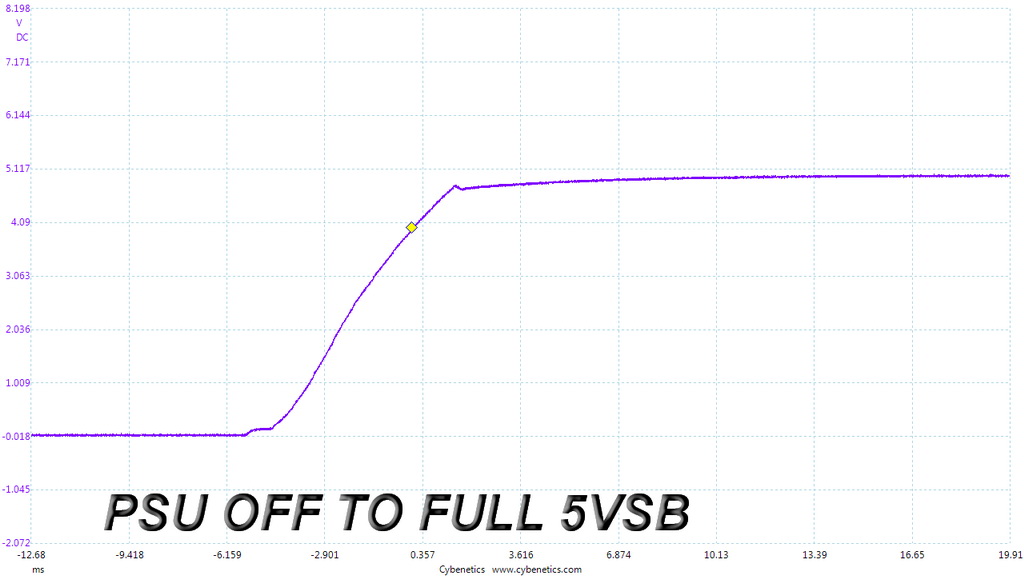


The SSR-750FX achieves smooth slopes in all three tests without any notable spikes. Overall, we observe pretty good performance.
MORE: Best Power Supplies
MORE: How We Test Power Supplies
MORE: All Power Supply Content
Current page: Transient Response Tests
Prev Page Cross-Load Tests & Infrared Images Next Page Ripple Measurements
Aris Mpitziopoulos is a contributing editor at Tom's Hardware, covering PSUs.
-
none77 Thank you for the detailed review.Reply
In the transient response test
Advanced Transient Response at 50 Percent – 200ms
the +3.3 pass.
-
BugariaM As always, here are the most detailed reviews on the PSU.Reply
Thank you and keep it up!
The only thing that is not quite clear to me. What is the criterion for voltage drop in % to get PASS/FAIL in "Advanced Transient Response Tests"?
You declare that:
"In all tests, we measure the voltage drops." The voltages should remain within the ATX specification's regulation limits. "
For ATX 2.2 we have:
12v - 10%
5v - 5%
3.3v - 5%
5VSB - 5%
However, looking at your reviews, there are often situations where, at <5%, the power supply gets the FAIL mark and vice versa, some at >5% receive PASS
Why is this happening? -
Aris_Mp the limit is 5% however the voltage rails of the PSUs' under test in the majority of cases aren't at the nominal voltages, but higher, so even with 5% deviation voltages go don't bellow the limits that the ATX spec sets (11.4V, 4.75V, 3.14V). Only if a rail goes below those voltage levels it fails. The 5% is just an indication that the ATX provides to specify the voltages above.Reply -
fredlaso Dell Inspiron 5675 Desktop, PSU (power supply unit), upgrade. Would this PSU compatible with Dell Inspiron 5675 Desktop. It came with 460W I would like to replace it with PSU between 650 to 750W. I tried at Dell forums but cannot get a clean link which one would be compatible.Reply
I would greatly appreciate if someone could help me out. Thank you kindly in advance:
http://en.community.dell.com/support-forums/desktop/f/3514/t/20019321?pi21953=1#21018407
http://en.community.dell.com/support-forums/desktop/f/3514/p/20024419/21031446#21031446
System Comp,:
Compatible Power Supply needed for Inspiron 5675 Gaming Power Supply
Specs:
AMD Ryzen 7 1700X 3.4GHz Octa-Core Processor
8GB 2400MHz DDR4 RAM
1TB 7200 RPM Hard Drive
AMD Radeon RX 580 8GB GDDR5 Graphics Card
DVD+RW Drive
Dual Band WiFi 802.11ac + Bluetooth 4.1
Windows 10 Home (64-bit)
460 Watt Power Supply w/ Polar Blue LED
Includes: Dell KB216 Wired Keyboard + Dell MS116 Wired Mouse
Ports:
6x USB 3.0
1x USB 3.1 Type-C Gen 1
2x USB 2.0
1x Audio Combo Jack
1x 3-in-1 Media Card Reader
1x P/S 2
1x 7.1 Channel Audio Out
Expansion Slots:
3x 3.5" bay
2x 2.5" bay
2x PCIe x1
2x PCIe x16
http://en.community.dell.com/support-forums/desktop/f/3514/t/20019321?pi21953=1#21018407
http://en.community.dell.com/support-forums/desktop/f/3514/p/20024419/21031446#21031446 -
paulinosaka My Seasonic Platinum began failing under load after only 10 months. Paid cash here in Japan at Joshin - couldnt find reciept - honestly never thought I would need it ever. Seasonic would not help me.?Reply
REPLY